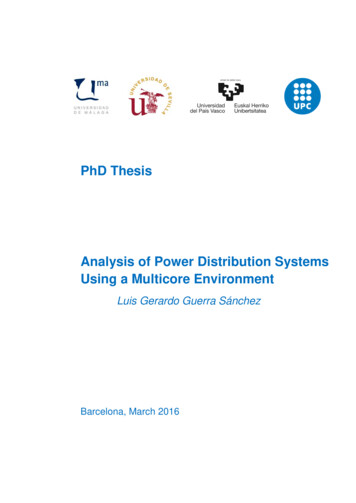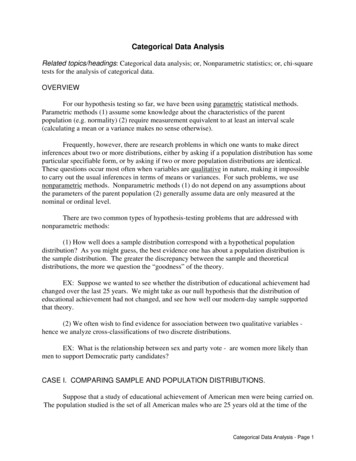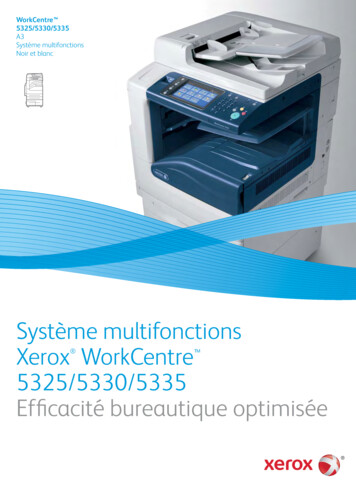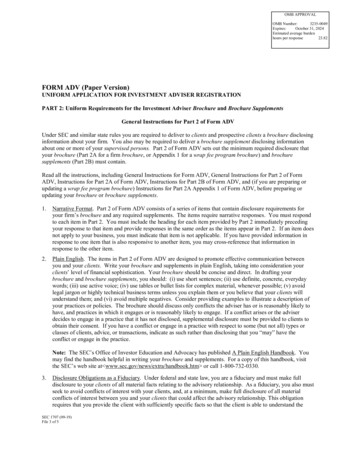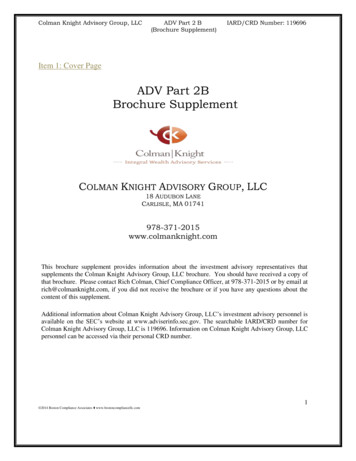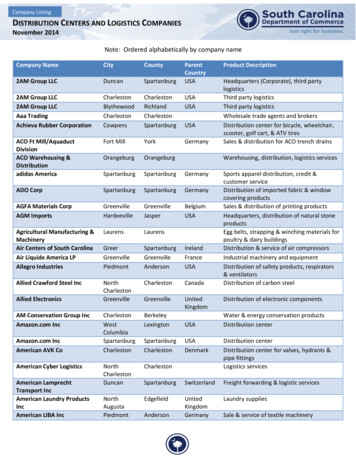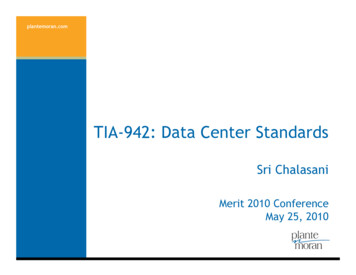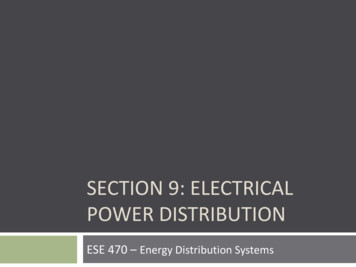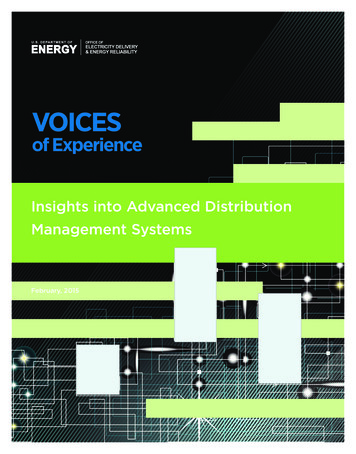
Transcription
VOICESof ExperienceInsights into Advanced DistributionManagement SystemsFebruary, 2015Voices of Experience Advanced Distribution Management Systems brochure.indd 12/11/15 12:52 PM
Prepared for the U.S. Department of Energy by the National RenewableEnergy Laboratory under contract No. DE-AC36-08G028308, SubtaskSG10.1011 in conjunction with Energetics Incorporated under contractNo. GS-10F-0103J, Subtask J3806.0002.Voices of Experience Advanced Distribution Management Systems brochure.indd 22/11/15 12:52 PM
Voices of Experience Advanced DistributionManagement SystemsWhen people think of the electric power grid, they tend to picture the massive high-voltage transmission lines and talltowers that march across the countryside. But the smaller medium- and low-voltage lines of the electric distributionsystem cover the most distance and deliver power to almost every home and business in the country.Considering that this is an era in which smart phones and Google Maps are ubiquitous, it may come as a surprise thatutilities have very little visibility into their distribution systems. Most systems still rely on breakers to disconnect the linesin the event of a fault, customers to call in to report an outage, and line crews to find the effected circuit and restorepower. However, this may be changing.Today, a number of utilities are implementing advanced distribution management systems (ADMS), a software platformthat integrates numerous utility systems and provides automated outage restoration and optimization of distributiongrid performance. ADMS functions can include automated fault location, isolation, and service restoration (FLISR);conservation voltage reduction; peak demand management; and volt/volt-ampere reactive (volt/VAR) optimization. Ineffect, an ADMS transitions utilities from paperwork, manual processes, and siloed software systems to systems withreal-time and near-real-time data, automated processes, and integrated systems.Why Are Utilities Implementing ADMS?That’s a fair question for a system that’s definition is somewhat nebulous, could end up costing two to three times more than anticipated,and its full functionality and benefits may not be realized for another 20 years. Yet, even though an ADMS is complicated, the answeris not: Utilities are deploying them because customers are demanding them. Customers are not specifically asking for a complicatedsystem of software codes, databases, servers, and other technologies, but they are looking for higher reliability, improved power quality,renewable energy sources, security of their data, and resiliency to natural disasters and other threats that disrupt the flow of power andtheir lifestyles.Utilities that are pioneering ADMS are investing in this technology because they believethe capabilities it enables are essential to the future of their business. As technologiesmature and distributed energy resources approach parity with traditional generationsources, customers are installing rooftop solar photovoltaic systems, electric vehicles,and other grid-connected devices that the utilities must accommodate. At the same time,regulators are developing policies that increase reliability and renewable energy portfoliostandards, and they are discussing fundamental changes to how distribution utilities areregulated to encourage the integration of renewables and overall grid efficiency. Utilitiesthat are investing in ADMS view it as necessary to stay relevant in the changing electricitybusiness.Although meeting the 21st-century demand for energy is the overarching reason to investin an ADMS, a unique set of circumstances drives each utility’s decision to transform theirdistribution system and the path and the pace of that transformation.Why invest in anintelligent, moderngrid?“There is no other choice customer expectations are goingto force grid modernization on uswhether we like it or not.”— Kenny Mercado, Senior VicePresident, Electric Operations,CenterPoint EnergyINSIGHTS INTO ADVANCED DISTRIBUTION MANAGEMENT SYSTEMS DOEVoices of Experience Advanced Distribution Management Systems brochure.indd 332/11/15 12:52 PM
The Reason for This GuideThe American Recovery and Reinvestment Act (ARRA) of 2009 spurred investmentsin smart grid technology and programs at utilities across the country. The Smart GridInvestment Grant program and Smart Grid Demonstration projects that it fundedprovided unprecedented opportunities to learn from smart grid implementation.In 2011, the U.S. Department of Energy, Office of Electricity Delivery and EnergyReliability (DOE OE), in partnership with electric utilities that received ARRA funds,convened a series of Regional Smart Grid Peer-to-Peer Workshops. These weredesigned to bring together utilities to engage in dialogues about the most compellingsmart grid topics in each region. The meetings offered a platform for smart gridimplementers at all stages of project deployment to share their experiences and learnfrom each other.Realizing the benefits of bringing utilities together to share their experiences, inFebruary 2014 DOE OE formed the ADMS Working Group by assembling a leadershipteam of representatives from the utility industry with the mission to collect theexperiences, insights, and lessons learned from implementing these systems. This guideis the result of a one-day meeting held at CenterPoint Energy in Houston, Texas, inMay 2014 that was followed by a series of conference calls about specific aspects ofADMS, interviews with individuals leading ADMS projects at their utilities, and a finalsmall group meeting at San Diego Gas & Electric in California in October 2014. Theinformation in this guide came directly from the people in the industry on the leadingedge of transforming their distribution systems. Although the working group includedmore than 40 people and represented 30 utilities and organizations, the following werekey contributors of their experience:“[Our customers,] like yourcustomers, like their electricity,which is reliable and safe andresilient ADMS is very, verykey to that, giving us opticsand transparency in real-timeinformation. We used to drivearound with flashlights at 2:00a.m. looking for a tree on thecircuit, and now we go to ourcontrol center and find out exactlywhere the fault is and expeditedeployment of a truck to fix theproblem.”······4 Drivers of ADMSInvestments:1.Resilience—the ability towithstand or recover from anatural disaster quickly.2.Renewables—the abilityto accommodate largerquantities of distributedenergy resources.3.Replacement—the ability tosupplement legacy systemsthat are unable to integratewith new technologies andthat staff can no longersupport.4.Regulation—the ability toaccommodate changes thatencourage reliability andefficiency.San Diego Gas & Electric (SDG&E)CenterPoint Energy (CPE)Austin EnergyDuke EnergyKansas City Power & Light (KCP&L)Pacific Gas & Electric (PG&E)We hope that sharing this information will help other utilities overcomeor avoid some of the challenges these first adopters identified and be ableto deploy their own ADMS successfully and efficiently.— Tracy Bridge,Executive Vice President andPresident of the Electric Division,CenterPoint Energy4INSIGHTS INTO ADVANCED DISTRIBUTION MANAGEMENT SYSTEMS DOEVoices of Experience Advanced Distribution Management Systems brochure.indd 42/11/15 12:52 PM
Using This GuideThe goal of this guide is to provide practical advice to assist you in deploying an ADMS at your utility. Utilities that have deployed smartgrid technologies have learned lessons and gained insights along the way—sometimes the hard way—that can be applied to new projectsas well as existing projects that may be expanding or are presenting challenges. A few things to note:· All utilities are different and have unique systems and requirements. This document is not a road map that must befollowed; it is a compilation of advice and insights that other utilities have learned through their own ADMS deployments.· A goal of this project was to capture information in the utilities’ own words. These are presented throughout the documentin quotations and sections called “What We Did,” and “Looking Back—What We Learned.”· Much of the advice and insights are not attributed to a single source, because they are summaries from group discussions.Likewise, some examples are not sourced to an individual or particular utility, because we wanted participants to speakfreely about what they learned—even if they learned what not to do.· Also, the working group identified a number of resources that might be helpful as you embark on your ADMSimplementation, including a number of documents produced by the Electric Power Research Institute (EPRI). The listprovided below is not intended to be comprehensive, but it offers additional information that might be useful.Additional Resouces—EPRIWhat is an ADMS?“An advanced distribution managementsystem (ADMS) is the software platformthat supports the full suite of distributionmanagement and optimization. An ADMSincludes functions that automate outagerestoration and optimize the performance ofthe distribution grid. ADMS functions beingdeveloped for electric utilities include faultlocation, isolation and restoration; volt/voltampere reactive optimization; conservationthrough voltage reduction; peak demandmanagement; and support for microgridsand electric vehicles.” Guidebook for Cost/Benefit Analysis of Smart GridDemonstration Projects Program on Technology Innovation: SeamlessEnergy Management System, Part I: Assessmentof Energy Management Systems and KeyTechnological Requirements Distribution Management Systems Planning Guide Integrating Smart Distributed Energy Resourceswith Distribution Management Systems Common Information Model (CIM) Conformity andInteroperability Test Procedure Development IntelliGrid Architecture Development forDistribution Systems Guidelines for Assisting Understanding and Useof IntelliGrid Architecture Recommendations:— Gartner IT Glossary.Distribution Operations Critical Needs for Distribution System OperationsSource: EPRIINSIGHTS INTO ADVANCED DISTRIBUTION MANAGEMENT SYSTEMS DOEVoices of Experience Advanced Distribution Management Systems brochure.indd 552/11/15 12:52 PM
Six Things You Should Know About ADMSThe discussions that contributed to the development of this document not only identified the challenges of implementing an ADMSbut they also underscored how participating utilities were clearly committed to the vision for their business and the capabilities ADMSenables. Utilities that had implemented ADMS were enthusiastic about passing on their insights so it might help other utilities developingand deploying their own. Conversations about functionality, vendors, information technology, communications systems, and many otherimportant aspects of the deployment process took place. Throughout the course of these conversations, several themes emerged:1.The decision to deploy an ADMS is a strategic initiative that must be championed at the highest level in the organization andaligned with the organization’s long-range vision.2.ADMS fundamentally changes how a utility operates. It requires organizational changes and new skills that affect people’sjobs.and that is never easy. Managing these changes is difficult, but important, and it is a significant part of an ADMSdeployment.3.An ADMS deployment requires a dedicated, cross-functional team that works together toward a common goal and has the supportof top management. (We heard the word cross-functional in almost every discussion.)4.Making the business case for an ADMS requires thinking differently about the cost-benefit analysis. Often, it is not only hard costsavings but soft savings, such as cost avoidance and increased customer satisfaction, that need to be included in the decision todeploy an ADMS, and these can be difficult to quantify.5.ADMS is a nascent industry that lacks mature, field-proven vendor products; however, the technolgy is evolving and vendors arean integral part of the process and must be viewed as strategic partners.6.Integration is difficult. Utility operating systems were traditionally custom-built over the course of several decades. Integratingnew systems, or getting them to “talk” to each other, is complicated and requires an information technology foundation that cansupport each component of an ADMS.Keys to Our Success Across organization—vision agreementand desired capabilities Knowledgeable and committed businessteam, electric operations members, andinformation technology members Strong teamwork—key members locatedtogether Extensive training across organizations Rigorous testing on functionality andintegrations Extensive pilot with key systemsintegrations Good vendor products and cooperation. It’s ready when it’s ready!— Tom Bialek, Chief Engineer,San Diego Gas & Electric6INSIGHTS INTO ADVANCED DISTRIBUTION MANAGEMENT SYSTEMS DOEVoices of Experience Advanced Distribution Management Systems brochure.indd 62/11/15 12:52 PM
At a GlanceGetting Started: Is This the Right Time?8Making the Business Case: Think Differently10Developing a Road Map: Plan Ahead13Defining Your Requirements: Be Specific15Selecting a Vendor: Pick a Good Partner18Preparing Your Data: Clean It Up (and Keep It Clean)22Integrating Your Systems: Nothing Integrates Easily27Managing Change: Change Is Difficult30Governing the Project: Key to Success35AppendixA: Requirements—ExamplesB: Kansas City Power &Light Distribution System InventoryOMSC: DOE Working Group MembersADMSD-SCADAAdvancedAppsSource: Austin EnergyINSIGHTS INTO ADVANCED DISTRIBUTION MANAGEMENT SYSTEMS DOEVoices of Experience Advanced Distribution Management Systems brochure.indd 772/11/15 12:52 PM
Getting Started: Is This the Right Time?Utilities that are in the very early stages of planning or deciding whether to invest in an ADMS want to know when is theright time to start. So we asked the working group if there is a tipping point at which they knew they needed an ADMS. Notsurprisingly, the answer was “It depends.” What it depends on is not only the vision of the utility, but also externalities—suchas policies, weather events, and customer expectations—specific to each utility’s location or organization that impact (or couldimpact) the business. Some of the externalities mentioned by participating utilities include:· Projections showing a growing number of rooftop solar photovoltaic systems;· Local, state, or national policies requiring utilities to show a reduction in greenhouse gas emissions or an increase in the useof renewable generation;· Analysis showing that enabling volt/VAR optimization capabilities is more cost-effective than acquiring or buildingadditional peaking capacity;· Having one or more legacy systems nearing the end of its life;· Being located in a region where hurricanes or other severe weather events create frequent and extensive outages; and· Changing customer expectations. The availability of new options and choices for customers means that a utility must meetnew demands or risk decreasing customer satisfaction.The decision to implement an ADMS starts with a vision of where the utility would like to be at some future date that is basedon the externalities specific to the utility. In addition, clearly articulating the utility’s vision and end goals is important andneeds to come from the executive leadership of the organization. Everyone working on the ADMS-including your vendorsmust understand where the company is going and how it will operate in the future. And you need to think ahead. An ADMSdeployment is a long and complex project. You do not want to wait until your current system fails.Bottom line: Think ahead. It’s time to consider an ADMS when you foresee that your current system will not be able torespond to the externalities affecting your business in 5 to 10 years.Insights· Business priorities unique to each utility will drive the design and timeline of your ADMS.· There has to be a clear vision—from the executive leadership—for how the utility will operate in the future. A change inexecutive leadership may change the corporate vision and subsequently the requirements for your deployment plan.· Vendors and utilities are learning together—both functionally and technically—as they implement ADMS. As thetechnology matures, some of these challenges may be resolved. The timing of your project will depend on yourutility’s goals and the state of your existing system. For some, waiting is an option; but for others, it is not. (Note: Noutility in the working group advised waiting for the technology to mature. If you keep waiting for the next version, youmay never jump in.)· Utilities need to evaluate smart grid technology similar to how they plan for future power needs; i.e., you don’t wait untilyou run out of power to build new generation. Implementing an ADMS tends to be a long-term project; it is not unusual fora utility spend two to four years implementing the technology. You don’t want to wait until after your current system fails tomeet your needs to start your ADMS project.· ADMS is an optimization tool. It is possible to do similar functions using other systems, but it cannot be done as well. Onceimplemented, an ADMS offers additional functionality that you cannot get following a traditional path of siloed systems.· Like other capital projects, an ADMS deployment takes time—usually several years—and it requires time for planning. Youdo not want to wait until your current system fails to start considering an ADMS at your utility.8INSIGHTS INTO ADVANCED DISTRIBUTION MANAGEMENT SYSTEMS DOEVoices of Experience Advanced Distribution Management Systems brochure.indd 82/11/15 12:52 PM
Advice· Start early and dedicate a lot of resources.· Think long term. Plans that look ahead 10, 20, and even 30 years are the norm. Utilities in the working group viewedADMS as evolving to integrate all types of “stuff” that will try to disrupt their grid in the future.· Start the project when the time is right for your organization. Do not wait until the next evolution of the technology; therewill always be something new.· Involve the right people—every business unit that will be using the system—in the planning stages. ADMS has a largenumber of interdependencies that cut across many departments. You have to break down those silos and bring peopletogether.· Front-load your project with time to develop use cases and other specifications. Planning is expensive and can be difficult tojustify to executives, but it is key to a successful project.· Include regulators in the conversation. The conversation may depend on the relationship you have with your regulator andwhat they think is important. If they need a business case that works from a financial perspective, you need to give themthat. You will also need to educate them on the technology and explain the benefits to them – this is a new product and thebenefits might not be readily apparent.· Build flexibility into your project plan that allows for scope changes as the project progresses or new capabilities aredesired.· Include stopgaps and contingency plans throughout the multiple project plans so that when there is a slippage in one projectthe overall implementation can continue and isn’t held up by the delay.Lessons Learned—InterfacesTreat interfaces as separate projects because they are huge, and that’s a big deal. ADMS implementation has a lot ofinterfaces—all those interfaces were all separate projects, and they should have been treated as such.Strategic Goals & Performance—Austin EnergyStrategy CategoryGoal by 2020Current StateRenewables35% with 200 MW Solar20% (2013)—on track to meet goal in2016CarbonCO2 power plant emissions reduction, 20%below 2005 levels17.6% reduction (2012)EfficienyDemand Side Management 800 MW371 MW savings (2013)Affordability 2% rate increase, in the lower 50% ofTexas retail salesBelow 2% and 50% of State (2013)Reliability 0.80 per year (SAIFI)FY 2013 SAIFI—0.59 60 minutes (SAIDI)FY 2013 SAIDI—46.24 3.00 (SATLPI)FY 2013 SATLPI—1.4483%71% (2013)Customer SatisfactionStrategic and performance goals such as these from Austin Energy are examples of externalitiesthat may factor into a utility’s decision to invest in an ADMS.INSIGHTS INTO ADVANCED DISTRIBUTION MANAGEMENT SYSTEMS DOEVoices of Experience Advanced Distribution Management Systems brochure.indd 992/11/15 12:52 PM
Making the Business Case: Think DifferentlyMaking the business case is one of the most significant challenges associated with ADMS. An ADMS can be difficult to justifyusing traditional business case methodology that compares the cost of the technology to the cost savings or increased revenueassociated with the benefits. Time frames for implementation tend to be long, and because it is an emerging technology, there isa lack of solid information about the true cost and the long-term benefits of this significant investment.Even so, the utilities that have implemented ADMS viewed it as a business strategy. It is a decision about how the utility willoperate in the future and the functionality that will be needed to meet customer expectations—now and into the future. Theseutilities based their business cases on the value of increased reliability, societal and soft savings such as the ability to combinesystems to provide optimization, run advanced applications, increased situational awareness, and others. And you have to ask,what are the benefits of getting information faster? Putting a value on these nontraditional elements can be a challenge, but it isnecessary to make a strong business case for ADMS.Bottom line: You have to think differently about your business case. An ADMS is not a technology that necessarily cutscosts; it adds capabilities and functionalities to support the company’s long-range vision.Insights· Utilities are finding that when using traditional methods, the costs of the system can quickly outweigh the benefits largelybecause the benefits are incremental and already accounted for in other systems.· Utilities must use nontraditional methods of determining benefits such as costavoidance rather than relying on hard cost savings to make the business case.These savings can be difficult to identify and quantify and even more difficult toget others in the utility to accept as part of the analysis.· Many of the intangible benefits such as faster outage response times, increasedcustomer satisfaction, increased visibility, and other operational benefits thatcome from ADMS are difficult to quantify and can stall the business case andproject implementation, but you are unlikely to make a positive business casewithout including them in the equations.· The cost of an ADMS project has many variables including the level ofintegration (how seamless is seamless), the degree of accuracy of the data yourequire, the functionality you want, the size of your system, and the currentaccuracy of your GIS. (GIS is usually the system on which the model is based.)· Operations and maintenance costs that are associated with new technologiesThe Cost of a PowerOutage“The U.S. Energy InformationAdministration estimates that the 150 billion in annual economiclosses because of outages isequivalent to adding 4 centsper kWh of costs to consumersnationwide.”— Annual Energy Outlook 2010,U.S. Department of Energyonce implementation is complete can be a significant expense for the utility.Factor this into the budget and determine what can be capitalized up front.Advice· Use available tools such as the Value of Service Study from the Lawrence Berkeley National Laboratory (LBNL) to helpput a value on increased reliability. Then consider how increased reliability or faster recovery times contribute to increasedcustomer satisfaction and what value can be placed on this.· Work with your subject matter experts from each operational unit to identify the benefits of your proposed ADMS. It’s hardto quantify some of the things you don’t yet know exist, but it’s a necessary step. Get your team to think about what will bepossible. This may take some time; one utility spent two weeks working through this exercise.· Identify efficiencies that can be gained by having an automated system in place rather than using multiple manualprocesses. For example, ADMS has been reported to be very helpful in identifying nested outages. Think about your ownsystem and estimate how much time will be saved by not having to redeploy a second crew.10INSIGHTS INTO ADVANCED DISTRIBUTION MANAGEMENT SYSTEMS DOEVoices of Experience Advanced Distribution Management Systems brochure.indd 102/11/15 12:52 PM
· Consider what happens to your organization when your ADMS implementation project is complete and your ADMSis operational. Does it reduce headcount? Or increase it? Do you need a more skilled workforce? A data scientist? Willadditional support from IT or other business units be required?· Estimate the cost to both obtain and then maintain the level of data model integrity that you have specified. The cost ofadopting processes and procedures needed to maintain the data on an ongoing basis is significant.· Include money to clean up your data. For example, you may need to verify that your GIS (if it is your system ofrecord) is accurate and includes all the attributes of the distribution network that will be required for the ADMS.· Include the cost and time to build a connectivity model for every single customer and every transformer. It is crucial toget the network model right and maintain it. Advanced applications require an accurate model.· Beware of unintended consequences. Trying to tie the business case too closely to reliability increases alone is riskybecause with advanced metering infrastructure (AMI) outage notifications are received quicker so SAIDI/SAIFInumbers could increase because of more accurate reporting.Looking Back—What We LearnedUnexpected Benefits· Initiate emergency voltage reduction faster (2.9% voltage reduction in 10 minutes); this is possible with SCADA butit’s faster with ADMS· Initiate demand response from ADMS· Integrate with microgrids· Incorporate distributed energy resources and forecasted load into the load model· Truly model distributed generation and not just negative loadStaffingUtilities in the working group reported needing additional staff, and typically this staff required a different skill set—moreinformation technology and electrical engineering skills. Plan for this up front. One company planned for one of the projectteam members to transition to the ADMS team once the implementation was complete. This allowed for increased buy-inand continuity.Capital Cost vs. Rate BaseSome utilities were able to include ADMS as part of their rate case (e.g., Duke Energy); others self-funded the project andcounted on improved operational efficiencies (e.g., SDG&E). If you plan to include your ADMS implementation as part ofyour rate case, begin informing and educating your regulators early in the process—inlcude them in the conversation. Youmay need to include time in your project plan to help inform your regulator/board so they understand the value of the newsystem and how it can improve operations and benefit customers.Data CleanupI just urge anybody that’s starting out on this to recognize that you will find one of those gaps that lead to your GIS data.Even if you’ve got good, clean data and you’ve got a good model, there will be land mines you can step on so just prepareyour budget and schedule for that. Put months in there for GIS data cleanup.Integration CostsIf I look back in time when we did the original business case, we ran out of money for most of the functionality specifiedin the original business case. And really, that money was spent around the integration pieces. I would have included moremoney for integration.Integration costs will probably be double or triple what you might expect.INSIGHTS INTO ADVANCED DISTRIBUTION MANAGEMENT SYSTEMS DOEVoices of Experience Advanced Distribution Management Systems brochure.indd 11112/11/15 12:52 PM
What We Did—NewRoles“Our Grid Management organizationhas nearly doubled since westarted the project. We have addedengineers, technicians, and a coupleof schedulers to help keep track ofit all. Two of the engineers have thetitle of DMS Optimization Engineer.Their job is to help us bring additionalvalue to the system because they nowhave increased visibility of the grid.Their job is to learn new things aboutthe system and figure out how tomake it work better.”— Michael Johnson, Project Director,Duke EnergyWhat We Did—Staffing for the Long TermWhen we deploy a project, we try to identify how manyadditional staff we will need post implementation. If weanticipate that at the end—post stabilization—that we willneed two additional full-time staff to support the end users(training, support, release cycles, and so on), then we includethis in the project resource plan. If we say we need five businesspersonnel to support the project, we hire two of those fivefrom the start and move them into the business team knowingthat they’ll inherit the support post project. The other threepersonnel that will be needed are temporarily upgradedfrom the line of business on a rotation for the duration of theproject. We also make sure that the line of business they’recoming from understands the impacts to their business from aproductivity standpoint and how long they’re going to be gone.And then, when the project’s done, they return to their originalclassification. Sometimes these are union employees; sometimesthese are management employees.Additional Resouces12 Value of Service Study, Lawrence Berkeley National Laboratory Interruption Cost Estimate (ICE) Calculator, U.S. Department of Energy Smart Grid Maturity Model, Carnegie Mellon UniversityINSIGHTS INTO ADVANCED DISTRIBUTION MANAGEMENT SYSTEMS DOEVoices of Experience Advanced Distribution Management Systems brochure.indd
conservation voltage reduction; peak demand management; and volt/volt-ampere reactive (volt/VAR) optimization. In e ect, an ADMS transitions utilities from paperwork, manual processes, and siloed software systems to systems with real-time and near-real-time data, automated processes, and integrated systems. Why Are Utilities Implementing ADMS?

